Nikon 1 V1 Review
Nikon 1 V1 Introduction
The Nikon 1 V1 is the flagship model in the new Nikon 1 system of Mirrorless ILCs. The system comprises of a new electric lens-mount paired with a 3:2 aspect ratio sensor having a 2.7X crop factor. This makes it possible to shrink Nikon 1 cameras and lenses compared to all but one system of SLDs.
Nikon developed a unique 10 megapixels high-speed CMOS sensor that is shared between the V1 and J1, the two cameras introduced at the launch. The 73-Point Phase-Detection autofocus system built straight onto the sensor is a first among mirrorless ILC. A full-resolution 60 FPS continuous drive and high-speed electronic-shutter is also unique among all ILCs.
The Nikon 1 V1 is a compact SLD with an ultra-sharp 1.4 megapixels EVF built-in. It offers complete manual-controls, including electronically-controlled manual-focus, custom white-balance and external lighting via a proprietary accessory port.
This detailed digital camera review takes a close look at the Nikon 1 V1's features, ergonomics, usability, image quality, performance and video recording features.
Nikon 1 V1 Major Features
- 10 Megapixels CMOS sensor
- 2.7X Crop factor, 3:2 aspect ratio
- Nikon 1 lens mount
- ISO range from 100 to 3200, Expandable to 6400
- Auto ISO with 400, 800 or 3200 maximum
- 1/16000One sixteenth thousandth of a second. Electronic shutter only. - 30s Shutter-Speed, Plus Bulb mode
- Multi-Segment, Center-Weighed and Spot metering
- PASM exposure modes, with Program-Shift
- Automatic Scene Selection mode
- Smart Photo Selector mode
- Exposure-Compensation: ±3 EV in 1/3 EV steps
- Automatic, 6 presetIncandescent, Fluorescent, Sunlight, Flash, Cloudy, Shade and custom white-balance, all fine-tunable along 2 axis in 13 steps
- Customizable sharpness, contrast, brightness, saturation and hue
- Single-Shot, Continuous, Manual and Auto focus-drives
- 73-Point Phase-Detect autofocus system
- 135-Point Contrast-Detect autofocus
- Autofocus assist lamp
- 60 FPS Continuous drive
- 10 FPS Drive with continuous autofocus
- 4 FPS Drive with mechanical shutter
- Self-Timer: 2, 5 and 10s
- Instant and 2s Delay remote
- Interval-Shooting, 1-999 Shots, 5s to 24h interval
- 100% Coverage 0.47" EVF 1.44 Megapixels with Eye-Start sensor
- 3” LCD with 920K Pixels
- 1920x1080 @ 30 FPS 1080p HD video
- 1280x720 @ 60 FPS HD video
- 640x240 @ 400 FPS High-Speed video
- 320x120 @ 1200 FPS High-Speed video
- 1920x1080 @ 60 FPS Motion-Snapshot
- 1072x720 @ 60 FPS 3:2 Video
- Internal stereo microphone
- Stereo sound input mini-jack
- JPEG and RAW modes
- Optional High-ISO noise reduction
- Optional Long-Exposure noise-reduction
- Optional Adaptive D-Lighting
- Hardware dust-reduction
- Lithium-ion battery
- SDXC Memory support
- Proprietary accessory port
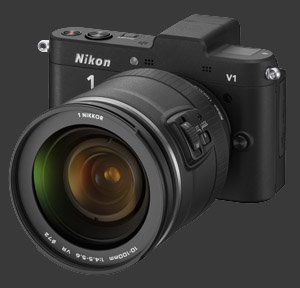
Nikon 1 V1 Suitability - What is it good for?
The Nikon 1 V1 features photographic controls similar to advanced compact digital cameras. Those include full manual controls, including manual focus, custom white-balance and detailed image parameters. This camera can record JPEG images, RAW files or both. This gives precise control over the creative aspect of photography.
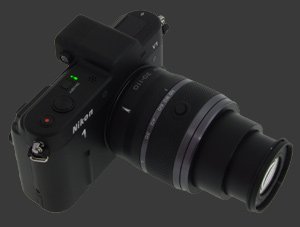
The major difference between this model and advanced compacts is that the Nikon 1 V1 is an Interchangeable Lens Camera (ILC). This provides tremendous versatility at the expense of cost in the form of lenses.
Since the Nikon 1 system is new, current native offerings are limited to a handful of basic lenses. An adaptor was announced which would allow the use of Nikkor lenses. Lenses with a built-in focus motor (AF-S) should be able to focus using that adaptor.
One obviously must consider that the size and weight advantages of a digital camera like the V1 disappear while using non-native lenses. By contrast, compact cameras have completely retractable lenses with over 10X optical zoom and protruding ones up to 36X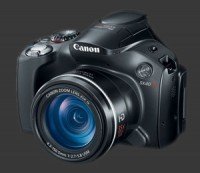
Canon Powershot SX40 HS.
The V1 uses a proprietary accessory port for external lighting instead of a standard hot-shoe. Eventually this will allow more sophisticated devices but for now, Nikon only makes one compatible flash. Even non-flash devices like a bubble-level cannot be attached to the accessory port.
The Nikon 1 V1 has both an standard mechanical shutter and an electronic shutter. The latter lets the V1 reach shutter-speeds of up to 1/16000s which is faster than any other ILC. It also enabled continuous shooting up to 60 FPS at full resolution with focus locked on the first frame or 10 FPS with continuous autofocus. This makes this camera well-suited for action photography. The electronic shutter also makes the V1 ultra-quiet, which is a tremendous advantage under certain circumstances.
Nikon 1 V1 Capability - What can it do?
The Nikon 1 V1 itself is a rather capable camera. Its feature-set includes a good part of what entry-level DSLRs can do, plus it has plenty of unique features of its own. The Nikon 1 system uses the same 3:2 aspect-ratio as most modern DSLRs, providing an exact match for the classic 4"x6" print. The V1 has a 10 megapixels CMOS sensor, good enough for sharp 10"x15" prints at low sensitivities.

There are presently 4 native lenses for the V1, spanning focal-lengths of 10 to 110mm. Considering the crop-factor of 2.7X, this covers a wide-angle 27mm to a telephoto 297mm. This covers a wide range of subjects from landscape to street shooting. While an F-mount lens can easily provide a longer reach, wider angle options are extremely limited.
The Nikon 1 mount is controls lenses electronically. Traditional mechanical zoom lenses plus power-zoom lenses are available. Autofocus is obviously supported as is manual focus which is performed by the control dial rather than a focus ring. Image stabilization is built into lenses but controlled and activated by the camera.
The standard PASM exposure modes are available for both images and videos. The right mode is chosen via the menu system rather than traditional mode-dial. EC is available ±3 steps in 1/3 EV increments. Actually, all exposure parameters other than ISO are always controlled in thirds.
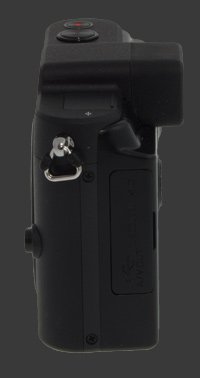
With a shutter-speed range of 1/16000s-30s, plus Bulb mode, the Nikon 1 V1 is suitable for photography in extremely bright to rather dim lighting. The standard ISO sensitivity range goes from 100 to 3200, with ISO 6400 as an expansion option. This is enough for general photography and is comparable to entry-level DSLRs.
Continuous shooting speeds are unmatched among ILCs, with up to 60 FPS at full-resolution. A large buffer lets it shoot up to 60 JPEG images or 30 RAW files. The V1 achieves this stellar speed in High-Speed Electronic-Shutter mode which forces automatic exposure including Auto ISO with a limit of 3200. Autofocus is locked on the first frame at drives speeds above 10 FPS. At 10 FPS though, continuous autofocus including subject-tracking is possible. When the mechanical shutter is enabled, the continuous drive drops to a respectable 4 FPS.
Nikon took a genuinely useful and unique approach to integrating images and video with this digital camera. In all image modes, the V1 can record video with a 3:2 aspect ratio at the unusual resolution of 1072x720. In the dedicated video mode which captures 16:9 aspect ratio HD video, the V1 can capture images of the same aspect ratio. The great thing about this is that correct framing is always previewed with 100% coverage. Kudos to Nikon for getting this right!
The high-speed CMOS sensor is used in both Smart Photo Selector and Motion Capture modes. Both these modes buffer from the moment the shutter is pressed halfway. The difference is that the former mode selects the 5 best images based on sharpness and composition, while the latter creates a slow-motion video from the second preceding the shutter-release. Motion Capture mode adds one of four fixed sound-tracks to the video.
The Nikon 1V1 provides flexible image parameters in the form of 6 predefined Picture Controls, one of which is B&W. Each style can be refined using 10 steps of sharpening, 7 of contrast, 3 of brightness, 7 of saturation and 7 of hue. White-Balance is quite flexible with an Auto mode, 6 presets and a custom setting. All WB settings are fine-tunable in 13-steps along 2 axis.
Drive modes include self-timers of 2s, 5s and 10s, plus both instant or 2s delayed remote trigger. There is no need for MLU on the V1. The is an Interval Shooting option which takes up to 999 images at intervals between 5s and 24h, assuming the batter holds that long.
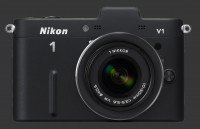 |
Please Support Neocamera
All information on Neocamera is provided free of charge yet running this website is a huge endeavor. Purchases made via affiliate links found throughout the site help keep it running and up-to-date. There is no additional cost to you, so please consider buying via these links to our affilates:
If you found any information on this site valuable and did not purchase via our affiliate links, please considering donating via PayPal:
Any amount will be greatly appreaciated. Thank you for your support!
Nikon V1 Highlights

Sensor-Size: 13 x 9mm

Actual size when viewed at 100 DPI
| 10 Megapixels Mirrorless | ISO 100-6400 |
| Nikon 1 Mount 2.7X FLM | Shutter 1/16000-30s |
| 0.47" Built-in EVF 1.4 Megapixels | Full manual controls, including Manual Focus |
| Automatic Eye-Start sensor | Custom white-balance |
| Built-in Dust Reduction | Spot-Metering |
| 60 FPS Drive, 60 Images | Hot-Shoe |
| 1920x1080 @ 30 FPS Video Recording | Stereo audio input |
| 3" LCD 920K Pixels | Lithium-Ion Battery |
| Secure Digital Extended Capacity |
Updates
2025.01.18

Fujifilm GFX 2025 Lens Roundup
Lens Review roundup of Fujifilm GFX Medium-Format lenses. Quality, performance and handling of the GF20-35mm F/4R WR, GF30mm F/3.5 Tilt-Shift and the GF55mm F/1.7.
2024.11.18

Best 2024 Photography Gifts for Every Budget
Great gifts for photographers and photo enthusiasts selected for every budget among the best products of 2024.
2024.08.07

Eye Protection Tips for Professional Photographers
The four main considerations for professional photographers regarding eyewear.
2024.07.14

Fujifilm X100VI Review
Flagship fixed-lens compact digital camera with a 40 MP sensor and Image-Stabilization, a first for the series. Retro design featuring dual control-dials, plus direct ISO, Shutter-Speed and EC dials. Its hybrid viewfinder can switch between EVF and OVF mode.
2024.05.09

Fujifilm GFX100 II Review
Flagship 102 Megapixels Medium-Format Mirrorless Digital Camera with 8-Stop 5-Axis IBIS, 8 FPS Drive, 8K Video and 400 MP Super-Resolution capture in a weatherproof and freezeproof body with dual control-dials and dual memory-card slots.
2024.04.03

Fujifilm X-T5 Review
Newest Fujifilm flagship boasting a 40 MP APS-C sensor, 5-axis IBIS with 7-stop efficiency, 15 FPS continuous drive, 6.2K Video capture, dual control-dials and dual SDXC UHS-II slots in a sturdy weatherproof and freezeproof body.
2023.11.20

Best Digital Cameras of 2023
Find out which are the Best Digital Cameras of 2023. All the new Mirrorless Digital Cameras from entry-level to high-end professional.
2023.07.10

Fujifilm X-H2 Review
40 Megapixels APS-C Hybrid Mirrorless Digital Camera with 7-stop IBIS. Fastest shutter ever and 8K video capture. Large builtin EVF with 0.8X magnification and 5.8 MP, plus an Eye-Start Sensor. Packed with features and large number of controls in a weatherproof and freezeproof body.
2023.05.07

Sony FE 20-70mm F/4G Review
Review of the unique Sony FE 20-70mm F/4G lens. The optical zoom of this lens spans ultra-wide-angle and medium focal-length coverage, making it one of the most versatile Full-Frame lenses on the market.
2023.01.15

Huion Inspiroy Dial 2 Review
Review of the Huion Inspiroy Dial 2 tablet, a medium sized drawing surface with dual dials and customizable buttons. Connects via USB-C or Bluetooth 5.0 with Windows, Linux and Android support.
2022.12.08

How to Pack for a Photo Trip
Find out how to pack for a travel photography trip, carry your gear safely while meeting airline regulations.
2022.11.13

Best Digital Cameras of 2022
The best digital cameras of 2022. A short list of the most outstanding models in their respective categories. Choose one for yourself or as a gift.












